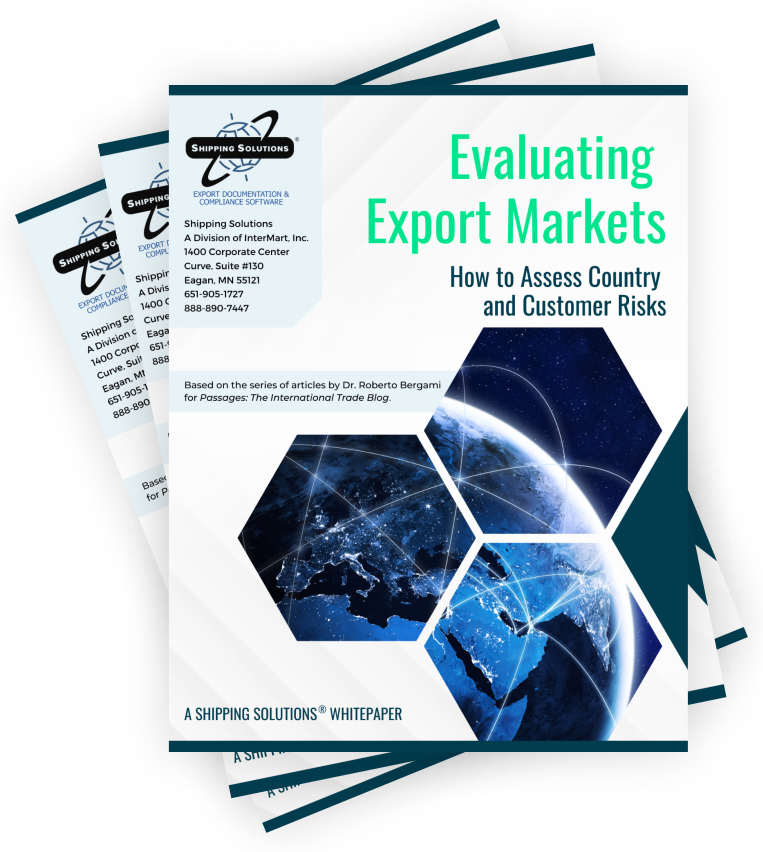The International Trade Blog International Sales & Marketing
Import-Export Due Diligence: Measuring Country Risk
On: October 9, 2023 | By:  Roberto Bergami |
5 min. read
Roberto Bergami |
5 min. read

As an exporter and/or an importer, it's not only important to understand the risks associated with doing business with particular companies or individuals, it's also important to assess the risk of the countries in which they are located.
A rogue customer in a good (from a risk perspective) country is not a much better risk than a good customer in a rogue (from a risk perspective) country.
In my last article, I discussed the importance of measuring corruption. In this article, I'm discussing tools for assessing country-specific risks.
Country Risk Assessment Model (CRAM)
One of the many wonderful things the Organisation for Economic Co-operation and Development (OECD) does is to measure country risk. They do so using a specifically devised model called the Country Risk Assessment Model.
All countries are categorized according to the credit risk they pose, consequently the categorization is meant to reflect country risk. According to the OECD:
Country risk encompasses transfer and convertibility risk (i.e. the risk a government imposes capital or exchange controls that prevent an entity from converting local currency into foreign currency and/or transferring funds to creditors located outside the country) and cases of force majeure (e.g. war, expropriation, revolution, civil disturbance, floods, earthquakes).
Several issues relevant to the OECD classification need to be explained. According to the rules, two groups of countries are not classified:
1. The first group is not classified for administrative purposes and is comprised of very small countries that do not generally receive official export credit support. For such countries, Participants are free to apply the country risk classification which they deem appropriate.
2. The second group of countries is comprised of High Income OECD countries and other High Income Euro-zone countries. Transactions involving obligors in these countries (and any countries classified in Category 0) are subject to the market pricing disciplines set out in Article 24c) and Annex X of the Arrangement.
All other countries (and a limited number of supranational multilateral/regional financial institutions) are classified into one of eight categories (0-7) through the application of a two-step methodology:
1. A quantitative model constructed specifically for this purpose: The Country Risk Assessment Model (CRAM) produces a quantitative assessment of country credit risk based on three groups of risk indicators (the payment experience reported by the Participants, the financial situation and the economic situation based primarily on IMF indicators).
2. A qualitative assessment of the CRAM results by country risk experts from OECD Members in order to integrate factors not fully taken into account by the model. This could lead to an adjustment (upwards or downwards) of a country compared to the CRAM results. Any adjustment has to attract a consensus among Experts.
The group of country risk experts meet several times a year. These meetings are organized so as to guarantee that every country is reviewed whenever a fundamental change is observed and at least once a year. The list of country risk classifications is publicly available and published on the OECD website after each meeting; however, the meetings themselves and the exchanges and deliberations that take place are strictly confidential.
Source: http://www.oecd.org/tad/xcred/crc.htm
Using the CRAM Data to Assess Risk
CRAM adopts both a quantitative and a qualitative approach to arrive at the best possible classification. Current data and historical data are freely available on the OECD website.
Based on these data, users may be able to do their own country risk assessment, by grouping certain countries using their own criteria. One common approach is to group countries by geographical location, for example, Southeast Asia or the ASEAN member nations. These groupings should detect patterns of risk that will reflect the economic status of the country and may also assist in gauging the risk levels of particular areas.
Whilst in these articles I make generalized statements, it is not unusual for certain geographical areas to share some risk commonalities. For example, many countries in Africa are categorized as high risk according to CRAM. Consequently, doing business in Africa will likely be comparatively more risky than doing business in parts of Asia or the Middle East. For sellers and buyers alike, the idea is to paint a picture about a country or an area; you may think of this as a quick reference guide or a shortcut to risk management.
If one knows that a particular area has high risk, you should approach these negotiations differently than negotiations in low-risk areas, and your business solutions may also be different or more restricted in choice. For example in risky countries Delivered Incoterms 2020 (DPU, DAP and DDP) may not be desirable options and more secure payment methods may also be required.
Of course, part of the examination of CRAM data is exactly what is required to arrive at our own country or country grouping classification.
It should be remembered that CRAM data, like any other data, is only partially useful in the analysis because of two primary reasons:
- Events in the world change quicker than the data can be published. For example, CRAM data is typically updated on a six-month basis, but events occur all the time.
- CRAM data has limitations, as outlined above. The difficulty with relying on one data set alone is highlighted by the current crisis in Cyprus. CRAM does not report any data for Cyprus because they are an EU member, but this does not mean that Cyprus is currently a highly acceptable risk.
It is therefore important to compare several sets of data to get a much more informed opinion—a more balanced and rounded view, if you like—of nations that we may be interested in doing business with.
I will review another set of data in my next article.
Like what you read? Join thousands of exporters and importers who subscribe to Passages: The International Trade Blog. You'll get the latest news and tips for exporters and importers delivered right to your inbox.

About the Author: Roberto Bergami
A full time member of staff at Victoria University, Melbourne, Australia, since 1998, Roberto holds a PhD (Thesis title Risk Management in Australian Manufacturing Exports: the Case of Letter of Credit to ASEAN), a Master in Education and Master of Business by Research (Applied Economics). Roberto additionally holds the Certified Documentary Credit Specialist qualification.
He is currently a Senior Lecturer in the College of Business and Visiting Professor at the University of South Bohemia in Ceske Budejovice, the Czech Republic. Roberto is also an Associate Researcher of the Centre for Cultural Diversity and Wellbeing and the Centre for Strategic and Economic Studies. Roberto has maintained his involvement with industry through a number of peak associations where he enjoys various grades of senior level membership.
Roberto’s main areas of research interests in international trade focus on government regulations, delivery terms (Incoterms), international payment terms and market entry barriers. His other research interests include the development of communities of practice, online teaching and online communities, migration from Emilia-Romagna (Italy) to Australia and teenage/youth dialect.


